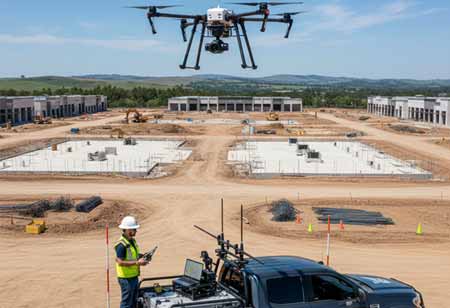THANK YOU FOR SUBSCRIBING
Be first to read the latest tech news, Industry Leader's Insights, and CIO interviews of medium and large enterprises exclusively from Applied Technology Review
Exploring Unprecedented Possibilities of Robotics in Deep-Sea Mining
The world is in a constant state of technological evolution, characterised by scientific advancements that catalyse innovation across diverse industries.

By
Applied Technology Review | Friday, October 06, 2023
Stay ahead of the industry with exclusive feature stories on the top companies, expert insights and the latest news delivered straight to your inbox. Subscribe today.
Leveraging robotics in deep-sea mining ensures long-term viability, enhances resource recovery efficiency and reduces environmental footprint, balancing the needs with the responsibility to safeguard the delicate ecosystems of the deep ocean.
FREMONT, CA: The world is in a constant state of technological evolution, characterised by scientific advancements that catalyse innovation across diverse industries. Deep-sea mining is a field experiencing rapid development owing to the continuous improvement of scientific instruments.
The deep-sea ecosystem holds a wealth of valuable minerals and substances awaiting extraction, ranging from polymetallic nodules and hydrothermal vents to cobalt-rich ferromanganese crusts and rare earth elements. However, the current emphasis is squarely on ensuring sustainability and environmental viability within deep-sea mining. Within this context, robotics has become a vital tool in reshaping the landscape of deep-sea mining, mitigating possible environmental repercussions and fostering sustainability.
Precise Resources Targeting and Minimal Ecological Disruption
Robots equipped with sophisticated sensors and precision instruments target and extract valuable minerals and metals from the ocean floor with high accuracy. This precision improves resource recovery while reducing waste, minimising the requirement for extra mining operations.
Advanced Sensing and Imaging
In the landscape of deep-sea mining, advanced sensing and imaging technologies in robotics systems play a pivotal role. These state-of-the-art technologies facilitate precise resource targeting and minimise ecological footprints. Leveraging these cutting-edge sensors allows deep-sea mining robots to navigate the pitch-black abyss with substantial accuracy, identifying mineral deposits, geological formations, and subtle seabed alterations that human eyes might overlook.
High-resolution cameras capture complex visual data, while sonar systems offer detailed spatial information, collectively providing a holistic view of the deep-sea environment. This sensory prowess enables robots to detect and evaluate important resource-rich areas with unprecedented precision. Meticulously mapping the ocean floor and detecting mineral-rich regions equip robots to lay the foundation for responsible and sustainable resource extraction. Unlike conventional mining methods that often lead to large-scale seabed disruption, these robotic systems minimise ecological repercussions by emphasising particular resource-rich zones. This targeted approach lowers the overall environmental impact on deep-sea mining operations.
Minimising Impact on Vulnerable Habitats
Deep-sea mining poses a considerable challenge to ecologically sensitive habitats, where the slightest disturbance might have far-reaching consequences for distinct marine ecosystems. This fragile ecosystem encompassing coral reefs and hydrothermal vent communities serves as an essential reservoir of biodiversity and provides valuable insights into the functioning of life in crucial conditions.
Within this context, a robotic system emerges as an efficient solution by providing efficient navigation through such environments with a level of accuracy that is unattainable for conventional mining methods. Robots effectively shield these vital areas from harm by avoiding sensitive habitats and reducing contact with fragile ecosystems.
This precision becomes even more critical in areas where unique and poorly understood ecosystems thrive. The capability of robotics to navigate with finesse in these ecologically sensitive zones underlines their significance in addressing the environmental impact of deep-sea mining while enabling individuals to decipher the treasures of the deep ocean responsibly.
Reducing Seabed Disturbance
Conventional mining methods often involve heavy machinery that churns up extensive amounts of sediment, making underwater plumes and disturbing marine ecosystems. Harnessing robotic capabilities facilitates operating closer to the seabed without causing excessive disruptions. This minimises the risk of sediment plumes and associated damage to marine life.
Real-Time Environmental Monitoring
Continuous Data collection
Robotic systems are characterised by an array of sensors designed to monitor diverse environmental parameters, encompassing water quality, temperature, pressure, and biological indicators. What distinguishes them is their capability to function in this data collection continuously and in real time.
This constant data stream offers a dynamic and precise portrayal of the conditions around mining operations, providing valuable insights into the real environment. This equips mining operators to promptly assess the impact of their activities and take proactive steps to address any potential harm. Consistent data collection enables operators to make informed decisions and respond to emerging scenarios, ultimately translating into responsible and sustainable deep-sea mining practices.
Ecosystem Health Assessment
Robotic systems stand pivotal in consistently monitoring and assessing ecosystem health in deep-sea environments. Leveraging the capability to accumulate data over extended periods enables them to provide valuable insights into poorly comprehended environments, empowering scientists to track how these ecosystems evolve in response to mining activities.
A proper understanding of the long-term effects of mining on deep-sea ecosystems facilitates the development of sustainable mining guidelines. This aids in striking a delicate balance between resource extraction and environmental conservation. These guidelines are paramount for ensuring the enduring well-being of these fragile ecosystems, protecting their distinct biodiversity and preserving their ecological functions in the face of increasing human activity in the ocean bed. Ultimately, robotic systems play a crucial role in this remote and mysterious realm, translating to responsible and sustainable deep-sea mining practices.
Improved Efficiency and Resource Recovery
Selective Extraction
Selective extraction stands as a remarkable capability of robotic systems in the landscape of deep-sea mining. These sophisticated machines possess the capability to distinguish between various types of m minerals, enabling them to selectively target and extract only relevant and useful resources. This precision-oriented approach holds immense importance in substantially minimising the volume of non-target materials brought to the surface.
This leads to mitigation of waste disposal and diminishing the environmental footprint of mining operations. This environmentally conscious approach underlines the crucial role of robotics in promoting responsible resource extraction from the deep sea while reducing the ecological repercussions and waste associated with conventional mining techniques.
Operational Continuity
Operational continuity represents a significant advantage of utilising robotic systems in deep-sea mining initiatives. These mysterious environments are characterised by high pressure, perpetual darkness, and frigid temperatures, causing considerable challenges for manual workers. Within this context, robotics are highly capable of enduring these harsh conditions, even with elevated precision and efficiency.
Their capacity to withstand such extreme conditions empowers uninterrupted resource extraction activities. This pinpoints the ability of robots to operate tirelessly and consistently, reducing the requirement for breaks, rest or other manual intervention. This unprecedented operational efficiency streamlines resource recovery and ensures the economic viability of deep-sea mining operations while conserving the fragile ecosystems of the deep ocean.
Ensuring Long-term Sustainability
Minimising Carbon Footprint
The reduction of the carbon footprint stands paramount in maintaining sustainable and responsible deep-sea mining. Conventional mining techniques often generate considerable carbon emissions as they belong to the energy-intensive process of lifting minerals from the ocean floor to the surface. Conversely, robotics provides a sustainable alternative.
These advanced systems are designed to harness electric or hybrid propulsion systems powered by renewable energy sources such as solar panels or wind turbines. This transition harmonises seamlessly with global endeavours to mitigate climate change by mitigating the carbon emissions associated with resource extraction. This underlines the significance of robotics in fostering environmentally responsible practices within the deep-sea mining industry while translating to a more sustainable future.
Remediation and Restoration
Leveraging robotic systems in remediation and restoration endeavours facilitates mitigating the consequences of mining. They assist in functions encompassing coral replanting, pollutant removal, and ecosystem rehabilitation, aiding in the recovery of affected regions.
As technology advances and regulatory frameworks evolve, the future of deep-sea mining offers unprecedented possibilities and promises for humanity and the planet. This ensures the responsible and sustainable extraction of the treasures hindered beneath the ocean's depths. Leveraging these unparalleled capabilities of robotics facilitates a strong balance between demand for essential minerals and responsibility to protect the ecosystems of the deep ocean.
I agree We use cookies on this website to enhance your user experience. By clicking any link on this page you are giving your consent for us to set cookies. More info








